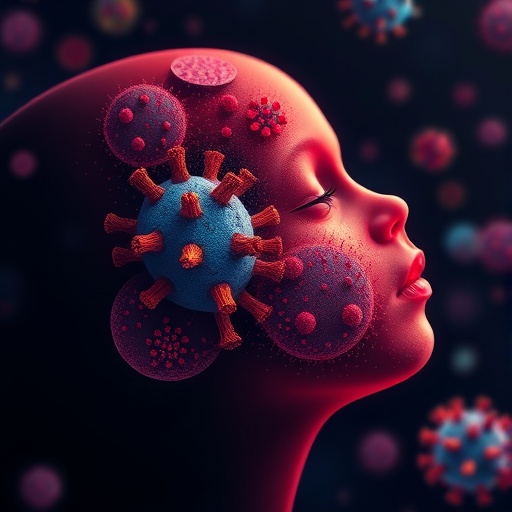In the wake of the global COVID-19 pandemic, scientific inquiry has vastly expanded to explore how viral outbreaks impact human health beyond direct infection. A pioneering recent study has now shed light on the subtle yet profound changes occurring within the microbial communities residing in children’s upper respiratory tracts. This investigation examined the nasopharyngeal and nasal cavity microbiota of healthy children before and during the COVID-19 pandemic, unveiling dynamic shifts that could carry implications for both disease susceptibility and long-term respiratory health.
The upper respiratory tract harbors a complex and diverse assembly of microorganisms, collectively referred to as the microbiota. These microbial populations are paramount in maintaining mucosal immunity, preventing pathogen colonization, and modulating inflammatory responses. Prior to the pandemic, baseline characterizations established a relatively stable microbiota composition in healthy pediatric populations. However, the advent of COVID-19, accompanied by widespread use of non-pharmaceutical interventions such as face masks, social distancing, and enhanced hygiene, introduced an unprecedented environmental upheaval influencing microbial ecosystems.
To interrogate these changes, researchers employed advanced genomic sequencing methodologies, notably 16S rRNA gene sequencing, to capture detailed taxonomic profiles of the microbial communities within the nasal cavity and nasopharynx. The study cohort encompassed healthy children sampled during two distinct time points—preceding the pandemic and deep into the COVID-19 era. This approach allowed the team to compare microbial diversity, relative abundance of key taxa, and overall community structure alterations influenced by pandemic-associated behavioral and environmental modifications.
.adsslot_r0hGWPDBuw{ width:728px !important; height:90px !important; }
@media (max-width:1199px) { .adsslot_r0hGWPDBuw{ width:468px !important; height:60px !important; } }
@media (max-width:767px) { .adsslot_r0hGWPDBuw{ width:320px !important; height:50px !important; } }
ADVERTISEMENT
Intriguingly, the findings revealed a significant reduction in microbial diversity within both the nasal cavity and nasopharynx during the pandemic when contrasted with pre-pandemic samples. Microbial diversity is widely recognized as an indicator of ecosystem resilience; thus, its diminishment suggests a potentially destabilized microbial milieu. Such reductions may stem from decreased social interactions among children, reduced exposure to environmental microbes, and shifts in respiratory health dynamics induced by mask-wearing and heightened hygiene standards.
Beyond overall diversity metrics, notable compositional shifts were observed. The relative abundance of certain commensal bacteria known for their protective roles, including genera such as Dolosigranulum and Corynebacterium, decreased significantly during the pandemic. These bacteria have previously been implicated in competing against pathogenic organisms and promoting mucosal barrier integrity. Concurrently, opportunistic bacteria exhibiting potential pathogenicity, such as Moraxella species, demonstrated increased relative abundance, raising concerns about altered susceptibility to respiratory infections post-pandemic.
These microbial community perturbations bear clinical relevance, as the nasopharynx and nasal microbiota can influence susceptibility to viral infections, allergic conditions, and chronic respiratory diseases such as asthma. The observed dysbiosis—a microbial imbalance—may modify the immunological landscape, potentially impacting children’s responses not only to SARS-CoV-2 but also to other respiratory pathogens. This insight emphasizes the indirect consequences of pandemic control measures on pediatric respiratory health beyond viral transmission suppression.
Further mechanistic interpretations postulate that the widespread use of face masks, while crucial for infection control, may have inadvertently limited microbial exchange between individuals, thereby restricting the natural acquisition and replenishment of beneficial microbes. Additionally, changes in outdoor activity patterns and reduced attendance in communal settings like schools could have curtailed microbial diversity by limiting environmental interactions. These behavioral factors synergistically contributed to the remodeling of upper respiratory tract microbial ecosystems.
The study also underscores the dynamic interplay between host immunity and microbiota composition. The immune system, especially in children, is highly plastic and responsive to microbial cues critical for maturation and homeostasis. Alterations in microbial community structure could, therefore, influence immune development trajectories, possibly affecting long-term health outcomes. Future longitudinal studies will be vital to elucidate whether pandemic-induced microbial shifts exert persistent effects or if microbiota resilience facilitates a gradual return to pre-pandemic equilibrium.
From a methodological perspective, this research leveraged cutting-edge bioinformatics to parse complex sequencing data, employing diversity indices such as Shannon and Simpson metrics, and sophisticated clustering algorithms to discern patterns. These analyses were critical in validating statistically significant changes while controlling for confounding variables, granting robustness to the conclusions. Such technical rigors highlight the growing sophistication with which microbiota studies can capture subtle environmental and behavioral impacts on human-associated microbial communities.
Moreover, the research delineated distinctions between the nasal cavity and nasopharynx microbiota, emphasizing their unique ecological niches and susceptibilities. The nasopharynx, serving as a primary viral replication site, showed more pronounced microbial alterations compared to the nasal cavity. This spatial heterogeneity demonstrates the importance of site-specific sampling in microbiota research and tailoring clinical interpretations according to anatomical context.
Looking forward, these insights open avenues for targeted interventions aimed at restoring microbial balance disrupted by pandemic conditions. Probiotic formulations or microbiota-directed therapies could be conceptualized as adjuncts to bolster mucosal health in children, especially those at heightened risk for respiratory ailments. Furthermore, understanding these microbial dynamics may enhance predictive models for respiratory disease susceptibility, aiding public health preparedness for future outbreaks.
The study’s revelations also provoke broader contemplation regarding the unintended health consequences of public health measures. While the primary goal of mitigating viral spread remains paramount, nuanced appreciation of collateral biological effects is essential. Integrative approaches balancing infection control with preservation of microbial diversity could inform more refined strategies during prolonged public health crises.
In summary, the comprehensive characterization of nasopharyngeal and nasal microbiota before and during the COVID-19 pandemic highlights critical changes reflective of altered environmental exposures and behaviors. The reduction in beneficial commensals alongside the rise of potentially pathogenic bacteria underscores a pandemic-era microbial signature with possible repercussions for pediatric respiratory health. This work accentuates the complex interdependencies between microbial ecosystems and host immunity within the context of global health challenges.
The importance of this research transcends the immediate pandemic context, offering a foundational understanding of how sudden societal shifts impact fundamental aspects of human biology. It stands as a testament to the intricate and sensitive relationships governing our microbial partners and emphasizes the necessity of preserving microbial diversity as a pillar of health.
Further research is crucial to expand these findings, exploring the long-term trajectories of nasopharyngeal microbiota, the functional consequences of dysbiosis, and potential mitigation strategies. As the world grapples with pandemic recovery and anticipates future infectious threats, the integration of microbiome science into public health narratives will be increasingly indispensable.
This landmark study not only enriches the scientific community’s grasp of microbiota dynamics amid unprecedented societal change but also alerts clinicians, researchers, and policymakers to the broader health dimensions influenced by pandemic-associated lifestyle adjustments. It heralds a new era of interdisciplinary investigations at the intersection of microbiology, immunology, pediatrics, and epidemiology.
Subject of Research: Impact of the COVID-19 pandemic on the microbiota of the nasopharynx and nasal cavity in healthy children
Article Title: Characteristics of the microbiota in the nasopharynx and nasal cavity of healthy children before and during the COVID-19 pandemic
Article References:
Liang, M., Wu, WJ., Li, L. et al. Characteristics of the microbiota in the nasopharynx and nasal cavity of healthy children before and during the COVID-19 pandemic. World J Pediatr (2025). https://doi.org/10.1007/s12519-025-00953-z
Image Credits: AI Generated
DOI: https://doi.org/10.1007/s12519-025-00953-z
Tags: children’s nasal microbiota changesCOVID-19 impact on upper respiratory healthdynamic shifts in children’s microbiotaenvironmental factors affecting microbiota in childrenface masks and nasal microbiota compositiongenomic sequencing of nasal microbiotaimplications of microbiota changes for disease susceptibilitylong-term effects of COVID-19 on respiratory microbiomemicrobial communities in children’s respiratory tractsmucosal immunity in childrennon-pharmaceutical interventions and microbiotapediatric respiratory health during pandemics





